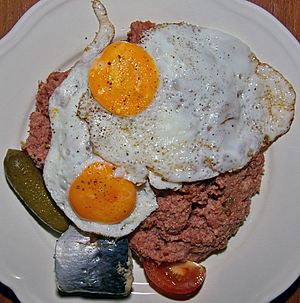Labskaus facts for kids
Labskaus is a special and tasty dish from northern Germany. It's very popular in cities like Bremen, Hamburg, and Lübeck. The main ingredients are salted meat (like corned beef), potatoes, and onion. Some recipes also include beetroot, pickled gherkin, or even herring. Other times, these ingredients are served on the side.
Contents
What is Labskaus?
Labskaus is a traditional meal often enjoyed in coastal areas. It's known for its unique look and hearty flavor. It's a great example of comfort food from northern Germany.
Where Does the Name Come From?
The exact origin of the word "Labskaus" is a bit of a mystery. One idea is that it comes from the Latvian words Labs kauss, which mean 'good bowl' or 'hotpot'. Another idea is from Lithuanian labas káušas, meaning the same thing.
This dish became very popular among sailors on big ships long ago. Potatoes and salted meats were common foods on voyages. Labskaus helped make meat that wasn't super fresh taste better. It also helped make the meat supply last longer for the crew. Today, you can still find Labskaus in restaurants along Germany's northern coast and in traditional Danish restaurants.
How is Labskaus Made?
To make Labskaus, people usually boil beef in a broth. Then, they mince (chop very finely) the beef with beetroot, onions, boiled potatoes, and sometimes herring. Some recipes use ham instead of beef. Finally, this mixture is fried in lard. Spices like nutmeg, pepper, coriander, or allspice are added for flavor.
The dish is quite similar to a British dish called hash.
Different Kinds of Labskaus
There are many different ways to make Labskaus. For example, in Bremen, which is about 95 kilometers (60 miles) from Hamburg, Labskaus is often made with fried corned beef, onions, and mashed potatoes. The beetroot and Rollmops (pickled herring) are usually served on the side, not mixed in.
You can also find similar dishes in Scandinavia, but they usually don't include herring. In Denmark, the dish is like the Bremen version, without herring, and sometimes with added gravy. In Sweden, a dish called Lapskojs is a stew made with beef and mashed potatoes. In Norway, the word lapskaus often refers to a type of beef stew that includes gravy. This Norwegian dish is quite similar to the "scouse" stew from Liverpool in England.
See also
 In Spanish: Labskaus para niños
In Spanish: Labskaus para niños



